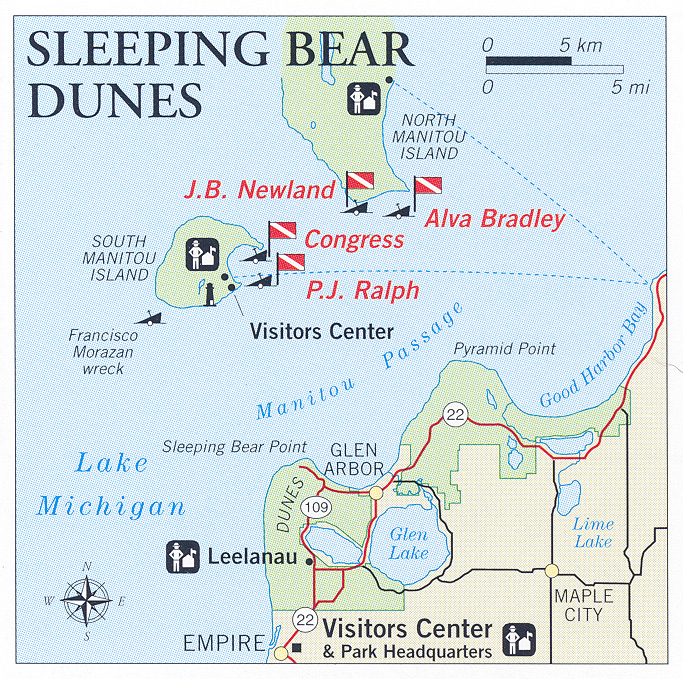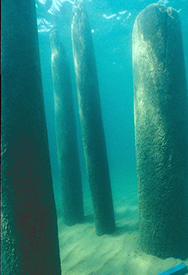Diving at Sleeping Bear National Lakeshore
“Sleeping Bear” is a sand dune that some people say resembles its namesake. The national lakeshore is a hilly, wooded, exceptionally attractive landscape along the northwestern shore of Michigan’s lower peninsula. Trailheads lead the hiker to the high fringe of sand dunes along miles of shoreline in the park and North and South Manitou islands include designated wilderness areas. It merits a diver's attention both as a diving destination and a place to spend some time engaged in more traditional park visitor pursuits. With its beech-maple forests, sand dunes, lighthouses, and excellent hiking trails, this is not the place for a drive-through, been-there, done-that kind of visit.
Of more particular interest to divers is the fact that the entire area including state and park bottomlands has been designated by the state of Michigan as the "Manitou Passage Underwater Preserve." The water is clear and there's a lot to see under the lake's surface, especially shipwrecks.
The wreck enthusiast should spend some nondiving time at the park walking the beaches. Dynamic sand dunes throughout the Lakeshore have covered over the remains of many vessels wrecked in the park's waters. At the whim of storms and shifting sands, the bones of these ships will periodically emerge from their beach burial sites, much like the wreck remains at Hatteras, Cape Cod, and other National Seashores. The park distributes a brochure on "Beachcombing for Shipwrecks" to help guide visitors to sites and assist them in understanding what they are seeing.
In 1996, a particularly interesting wreck was uncovered in the area. Three Brothers, a steamer built for the lumber trade in 1888, sank in a 1911 storm off South Manitou Island. Sanded over since shortly after its sinking, it lay buried for decades, a highly preserved maritime time capsule. The ship caused quite a stir when its made a surprise curtain call in the public consciousness 85 years later.
BASICS
Location: In Michigan on shore of Lake Michigan
Elevation: 580 feet
Skill level: Intermediate-advanced
Access: Boat or shore
Dive support: Traverse City, MI
Best time of year: Summer
Visibility: Moderate to good (20 to 40 feet)
Highlights: Shipwrecks
Concerns: Strong currents
Rules and Regulations
Dive Site Map
Dive Overview
There are 33 recreational diving sites in the Manitou Preserve, almost all of which are also within the boundary of the National Lakeshore. The sites include shipwrecks and maritime-related facilities such old docks.
Dive Sites
ALVA BRADLEY
The Alva Bradley was one of the earliest built of a class of approximately 200-foot Great Lakes schooners. It was built in 1870 and wrecked on the North Manitou shoal in 1894 when its tow-line parted while it was serving as a schooner-barge. The site is located one and a half miles south of Miller Beach, off North Manitou Island, in 26 feet of water. The ship has disarticulated along the turn of the bilge on both sides and there are major debris fields associated with the wreckage. It's a fascinating dive with numerous turn-of-the century artifacts to be seen and enjoyed. This shoal area can be subject to strong currents.
P.J. RALPH
This 211-foot wooden steam barge was built in 1889 and wrecked off South Manitou Island in 1924. The vessel was partially dynamited to remove its cargo of pulpwood. Swim about 1,300 feet north of the island marina building to see the pieces of hull and machinery that are the main visible parts of the wreckage. The largest piece of hull and a boiler is in 40 feet of water and the engine is near the shore in 16 feet of water.
J. B. NEWLAND
The remains of this wooden schooner lie in a 10-foot-deep scour surrounded by the four-foot-deep waters of the North Manitou Shoal. It is an interesting and safe site for snorkeling or beginning divers. If someone gets into trouble, they can always swim out of the scour and stand up. The ship was built in 1870 and lost in 1910 without loss of life. We saw some zebra mussels at the site in 1994, so the wreck might look very different by the time you get there.
CONGRESS
The depth of this site puts it toward the death-cheating end of the scale. The Congress is a very early steam-barge originally named Nebraska. Built in 1867, it was waiting out a storm in October of 1904 at a dock on South Manitou Island when a fire broke out. The ship was towed away from the dock by the Life Saving Service and sank in 160 feet of water. It has been frequently dived, but its depth limits it strictly to advanced wreck divers. It would definitely be a good dive for those interested in early Great Lakes steam technology.
THREE BROTHERS
As mentioned in the introduction, the largely intact remains of this steamer made a reappearance in 1996. In April of that year, NPS employees reopening an area of South Manitou for summer visitation noted that the spit that had been led "Sandy Point" was gone. The object around which the spit had apparently formed was, however, now exposed, and turned out to be the Three Brothers. This is a spectacular dive and an easy one, ranging from 10 to 40 feet in depth. You should put it on your "must see" list for the park and for Michigan in general. Over 1,000 divers visited the wreck in the short dive season after its discovery, making it the most popular diving destination in Michigan according to state archaeologist John Halsey. Given its history of coming and going it is not a dive you want to put off. It would be a shame to arrive with great expectations only to find Sandy Point again and no Three Brothers.
DIVING RULES AND REGULATIONS
Diver-down flag must be displayed while divers are in the water.
No taking of historic artifacts is allowed in any National Park.
State of Michigan Department of Natural Resources rules apply; a fishing license is required.
Last Updated: November 1, 2012








